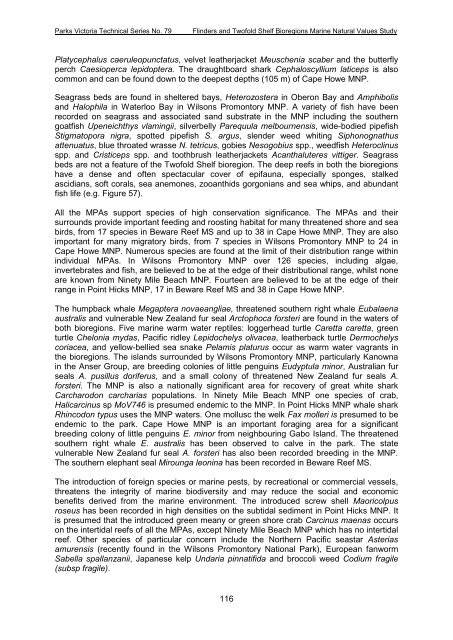parks victoria technical series marine natural values study vol 2 ...
parks victoria technical series marine natural values study vol 2 ...
parks victoria technical series marine natural values study vol 2 ...
You also want an ePaper? Increase the reach of your titles
YUMPU automatically turns print PDFs into web optimized ePapers that Google loves.
Parks Victoria Technical Series No. 79<br />
Flinders and Twofold Shelf Bioregions Marine Natural Values Study<br />
Platycephalus caeruleopunctatus, velvet leatherjacket Meuschenia scaber and the butterfly<br />
perch Caesioperca lepidoptera. The draughtboard shark Cephaloscyllium laticeps is also<br />
common and can be found down to the deepest depths (105 m) of Cape Howe MNP.<br />
Seagrass beds are found in sheltered bays, Heterozostera in Oberon Bay and Amphibolis<br />
and Halophila in Waterloo Bay in Wilsons Promontory MNP. A variety of fish have been<br />
recorded on seagrass and associated sand substrate in the MNP including the southern<br />
goatfish Upeneichthys vlamingii, silverbelly Parequula melbournensis, wide-bodied pipefish<br />
Stigmatopora nigra, spotted pipefish S. argus, slender weed whiting Siphonognathus<br />
attenuatus, blue throated wrasse N. tetricus, gobies Nesogobius spp., weedfish Heteroclinus<br />
spp. and Cristiceps spp. and toothbrush leatherjackets Acanthaluteres vittiger. Seagrass<br />
beds are not a feature of the Twofold Shelf bioregion. The deep reefs in both the bioregions<br />
have a dense and often spectacular cover of epifauna, especially sponges, stalked<br />
ascidians, soft corals, sea anemones, zooanthids gorgonians and sea whips, and abundant<br />
fish life (e.g. Figure 57).<br />
All the MPAs support species of high conservation significance. The MPAs and their<br />
surrounds provide important feeding and roosting habitat for many threatened shore and sea<br />
birds, from 17 species in Beware Reef MS and up to 38 in Cape Howe MNP. They are also<br />
important for many migratory birds, from 7 species in Wilsons Promontory MNP to 24 in<br />
Cape Howe MNP. Numerous species are found at the limit of their distribution range within<br />
individual MPAs. In Wilsons Promontory MNP over 126 species, including algae,<br />
invertebrates and fish, are believed to be at the edge of their distributional range, whilst none<br />
are known from Ninety Mile Beach MNP. Fourteen are believed to be at the edge of their<br />
range in Point Hicks MNP, 17 in Beware Reef MS and 38 in Cape Howe MNP.<br />
The humpback whale Megaptera novaeangliae, threatened southern right whale Eubalaena<br />
australis and vulnerable New Zealand fur seal Arctophoca forsteri are found in the waters of<br />
both bioregions. Five <strong>marine</strong> warm water reptiles: loggerhead turtle Caretta caretta, green<br />
turtle Chelonia mydas, Pacific ridley Lepidochelys olivacea, leatherback turtle Dermochelys<br />
coriacea, and yellow-bellied sea snake Pelamis platurus occur as warm water vagrants in<br />
the bioregions. The islands surrounded by Wilsons Promontory MNP, particularly Kanowna<br />
in the Anser Group, are breeding colonies of little penguins Eudyptula minor, Australian fur<br />
seals A. pusillus doriferus, and a small colony of threatened New Zealand fur seals A.<br />
forsteri. The MNP is also a nationally significant area for recovery of great white shark<br />
Carcharodon carcharias populations. In Ninety Mile Beach MNP one species of crab,<br />
Halicarcinus sp MoV746 is presumed endemic to the MNP. In Point Hicks MNP whale shark<br />
Rhincodon typus uses the MNP waters. One mollusc the welk Fax molleri is presumed to be<br />
endemic to the park. Cape Howe MNP is an important foraging area for a significant<br />
breeding colony of little penguins E. minor from neighbouring Gabo Island. The threatened<br />
southern right whale E. australis has been observed to calve in the park. The state<br />
vulnerable New Zealand fur seal A. forsteri has also been recorded breeding in the MNP.<br />
The southern elephant seal Mirounga leonina has been recorded in Beware Reef MS.<br />
The introduction of foreign species or <strong>marine</strong> pests, by recreational or commercial vessels,<br />
threatens the integrity of <strong>marine</strong> biodiversity and may reduce the social and economic<br />
benefits derived from the <strong>marine</strong> environment. The introduced screw shell Maoricolpus<br />
roseus has been recorded in high densities on the subtidal sediment in Point Hicks MNP. It<br />
is presumed that the introduced green meany or green shore crab Carcinus maenas occurs<br />
on the intertidal reefs of all the MPAs, except Ninety Mile Beach MNP which has no intertidal<br />
reef. Other species of particular concern include the Northern Pacific seastar Asterias<br />
amurensis (recently found in the Wilsons Promontory National Park), European fanworm<br />
Sabella spallanzanii, Japanese kelp Undaria pinnatifida and broccoli weed Codium fragile<br />
(subsp fragile).<br />
116

















